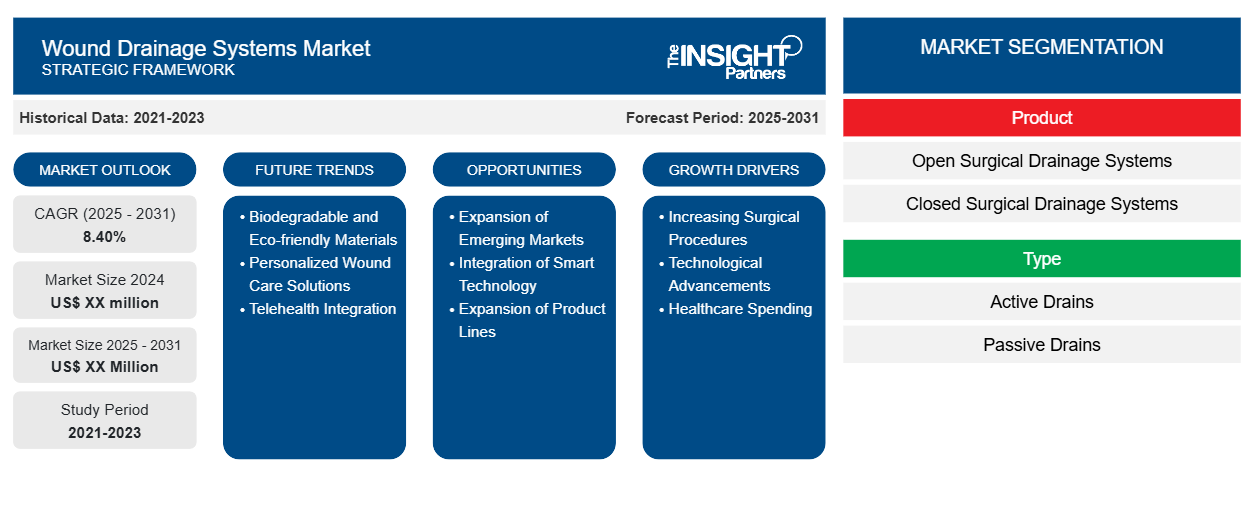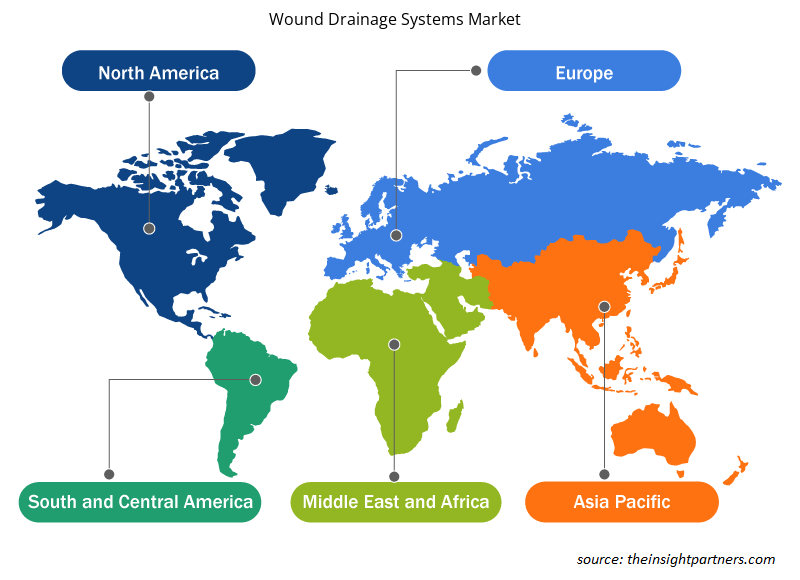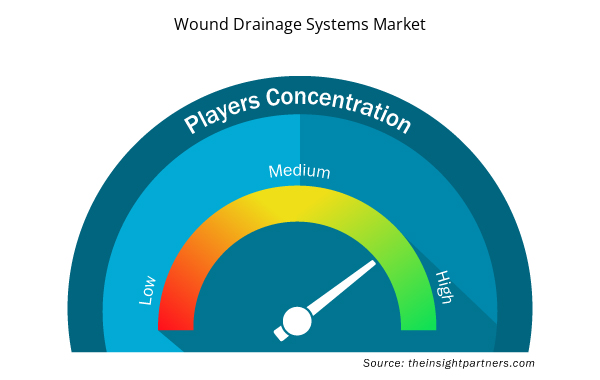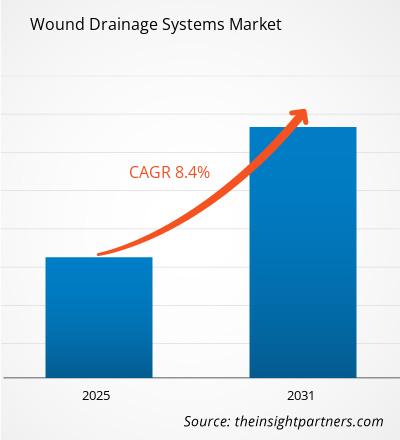Le marché des systèmes de drainage des plaies devrait enregistrer un TCAC de 8,40 % de 2024 à 2031, avec une taille de marché passant de XX millions USD en 2024 à XX millions USD d'ici 2031.
Le rapport présente une analyse basée sur les produits (systèmes de drainage chirurgical ouverts, systèmes de drainage chirurgical fermés). Le rapport fournit en outre une analyse basée sur les applications (chirurgie générale, chirurgie cardiaque et thoracique, chirurgie orthopédique, chirurgie obstétrique/gynécologique et autres). L'analyse mondiale est ensuite décomposée au niveau régional et par principaux pays. La taille du marché et les prévisions aux niveaux mondial, régional et national pour tous les segments de marché clés sont couvertes dans le cadre du périmètre. Le rapport offre la valeur en USD pour l'analyse et les segments ci-dessus. Le rapport fournit des statistiques clés sur l'état du marché des principaux acteurs du marché et présente les tendances et les opportunités du marché.
Objectif du rapport
Le rapport sur le marché des systèmes de drainage des plaies de The Insight Partners vise à décrire le paysage actuel et la croissance future, les principaux facteurs moteurs, les défis et les opportunités. Cela fournira des informations à diverses parties prenantes commerciales, telles que :
- Fournisseurs/fabricants de technologie : pour comprendre l’évolution de la dynamique du marché et connaître les opportunités de croissance potentielles, leur permettant de prendre des décisions stratégiques éclairées.
- Investisseurs : Effectuer une analyse complète des tendances concernant le taux de croissance du marché, les projections financières du marché et les opportunités qui existent tout au long de la chaîne de valeur.
- Organismes de réglementation : Réglementer les politiques et surveiller les activités du marché dans le but de minimiser les abus, de préserver la confiance des investisseurs et de maintenir l’intégrité et la stabilité du marché.
Segmentation du marché des systèmes de drainage des plaies
Produit
- Systèmes de drainage chirurgical ouverts
- Systèmes de drainage chirurgical fermés
Taper
- Drains actifs
- Drains passifs
Applications
- Chirurgie générale
- Chirurgie cardiaque et thoracique
- Chirurgie orthopédique
- Chirurgie obstétrique/gynécologique
- Autres
Géographie
- Amérique du Nord
- Europe
- Asie-Pacifique
- Amérique du Sud et Amérique centrale
- Moyen-Orient et Afrique
Personnalisez ce rapport en fonction de vos besoins
Vous bénéficierez d'une personnalisation gratuite de n'importe quel rapport, y compris de certaines parties de ce rapport, d'une analyse au niveau des pays, d'un pack de données Excel, ainsi que de superbes offres et réductions pour les start-ups et les universités.
Marché des systèmes de drainage des plaies : informations stratégiques

- Obtenez les principales tendances clés du marché de ce rapport.Cet échantillon GRATUIT comprendra une analyse de données, allant des tendances du marché aux estimations et prévisions.
Facteurs de croissance du marché des systèmes de drainage des plaies
- Augmentation des interventions chirurgicales : les écarteurs chirurgicaux aident les chirurgiens et les professionnels de la salle d'opération à maintenir une incision ou une plaie ouverte pendant les interventions chirurgicales. Le nombre croissant d'interventions chirurgicales dans le monde, alimenté par le vieillissement de la population et les maladies chroniques, devrait stimuler la demande d'outils de rétraction efficaces pour améliorer la visibilité et l'accès ; ce qui, à son tour, alimente la croissance du marché et l'innovation dans le domaine des écarteurs.
- Progrès technologiques : Les progrès en matière de conception et de matériaux des écarteurs médicaux ont amélioré la fonctionnalité et l'utilisation. Les écarteurs intelligents avec systèmes d'imagerie intégrés, la conception ergonomique et les matériaux légers ont amélioré l'efficacité et les résultats chirurgicaux. Ces innovations incitent davantage de prestataires de soins de santé à les utiliser, augmentant ainsi la taille du marché car les hôpitaux investissent continuellement dans des instruments chirurgicaux modernes qui peuvent aider à améliorer les soins aux patients.
- Dépenses de santé : Les investissements plus importants que les économies émergentes et le monde entier font dans les dépenses de santé contribuent au développement des investissements dans les infrastructures et les équipements chirurgicaux. Dans ce contexte, les investissements massifs observés dans le développement des services hospitaliers sont largement associés à des écarteurs médicaux de haute qualité pour la mise à niveau des installations et des équipements constants.
Tendances futures du marché des systèmes de drainage des plaies
- Matériaux biodégradables et respectueux de l'environnement : les matériaux biodégradables et respectueux de l'environnement sont actuellement à la mode pour la fabrication de systèmes de drainage des plaies. Dans un souci de réduction des déchets, les produits durables deviennent une exigence clé des établissements de santé, encourageant ainsi les innovations permettant un drainage efficace sans compromettre la conception environnementale.
- Solutions personnalisées de soins des plaies : la médecine personnalisée influence le marché des systèmes de drainage des plaies, offrant des solutions sur mesure pour répondre aux besoins de patients spécifiques. En fournissant des solutions de drainage personnalisables qui s'adaptent à des types spécifiques de plaies pour des conditions de patients spécifiques, les résultats du traitement peuvent être améliorés et la satisfaction des patients peut être augmentée.
- Intégration de la télésanté : L’émergence des services de télésanté remodèle le paysage de la gestion des plaies, permettant aux prestataires de soins de soigner les patients à distance. Les systèmes de drainage des plaies numériques peuvent relayer des informations au clinicien, permettant ainsi des actions rapides et une meilleure prestation de soins aux patients, propulsant la croissance du marché des systèmes de drainage des plaies, à mesure que la télémédecine gagne en popularité.
Opportunités de marché pour les systèmes de drainage des plaies
- Expansion des marchés émergents : les fabricants ont une occasion en or de se développer sur les marchés émergents, car ces marchés bénéficient d'une infrastructure de soins de santé en amélioration. Avec l'augmentation de l'accès global à la chirurgie, le besoin de systèmes de drainage des plaies devrait augmenter sur ces marchés, offrant aux fabricants un public cible et un potentiel de revenus croissant.
- Intégration de la technologie intelligente : L'adoption croissante de la technologie intelligente dans les systèmes de drainage des plaies permet une surveillance en temps réel des niveaux de liquide et de l'état du patient. De tels systèmes intelligents pourraient alerter les professionnels de santé d'éventuelles complications, contribuant ainsi à améliorer la sécurité des patients et la gestion proactive de la cicatrisation des plaies, ouvrant ainsi la voie à la croissance du marché.
- Élargissement des gammes de produits : les fabricants ont la possibilité d'élargir leur offre de produits en développant des produits complémentaires, par exemple des pansements avancés ou des systèmes de drainage intégrés. Cette expansion permettra de proposer une gamme plus étendue d'interventions chirurgicales et de types de plaies, augmentant ainsi la part de marché et offrant une solution plus complète aux prestataires de soins de santé, améliorant ainsi le marché du drainage des plaies.
Aperçu régional du marché des systèmes de drainage des plaies
Les tendances et facteurs régionaux influençant le marché des systèmes de drainage des plaies tout au long de la période de prévision ont été expliqués en détail par les analystes d’Insight Partners. Cette section traite également des segments et de la géographie du marché des systèmes de drainage des plaies en Amérique du Nord, en Europe, en Asie-Pacifique, au Moyen-Orient et en Afrique, ainsi qu’en Amérique du Sud et en Amérique centrale.

- Obtenez les données régionales spécifiques au marché des systèmes de drainage des plaies
Portée du rapport sur le marché des systèmes de drainage des plaies
| Attribut de rapport | Détails |
|---|---|
| Taille du marché en 2024 | XX millions de dollars américains |
| Taille du marché d'ici 2031 | XX millions de dollars américains |
| Taux de croissance annuel composé mondial (2025-2031) | 8,40% |
| Données historiques | 2021-2023 |
| Période de prévision | 2025-2031 |
| Segments couverts | Par produit
|
| Régions et pays couverts | Amérique du Nord
|
| Leaders du marché et profils d'entreprises clés |
|
Densité des acteurs du marché des systèmes de drainage des plaies : comprendre son impact sur la dynamique commerciale
Le marché des systèmes de drainage des plaies connaît une croissance rapide, tirée par la demande croissante des utilisateurs finaux en raison de facteurs tels que l'évolution des préférences des consommateurs, les avancées technologiques et une plus grande sensibilisation aux avantages du produit. À mesure que la demande augmente, les entreprises élargissent leurs offres, innovent pour répondre aux besoins des consommateurs et capitalisent sur les tendances émergentes, ce qui alimente davantage la croissance du marché.
La densité des acteurs du marché fait référence à la répartition des entreprises ou des sociétés opérant sur un marché ou un secteur particulier. Elle indique le nombre de concurrents (acteurs du marché) présents sur un marché donné par rapport à sa taille ou à sa valeur marchande totale.
Les principales entreprises opérant sur le marché des systèmes de drainage des plaies sont :
- CR Bard, Inc.
- Stryker
- Cuisiner
- Degania Silicone Ltée.
- Poly Medicure Limitée
Avis de non-responsabilité : les sociétés répertoriées ci-dessus ne sont pas classées dans un ordre particulier.

- Obtenez un aperçu des principaux acteurs du marché des systèmes de drainage des plaies
Principaux arguments de vente
- Couverture complète : Le rapport couvre de manière exhaustive l’analyse des produits, des services, des types et des utilisateurs finaux du marché des systèmes de drainage des plaies, offrant un paysage holistique.
- Analyse d’experts : Le rapport est compilé sur la base d’une compréhension approfondie des experts et analystes du secteur.
- Informations à jour : Le rapport garantit la pertinence commerciale en raison de sa couverture des informations récentes et des tendances des données.
- Options de personnalisation : ce rapport peut être personnalisé pour répondre aux exigences spécifiques du client et s'adapter parfaitement aux stratégies commerciales.
Le rapport de recherche sur le marché des systèmes de drainage des plaies peut donc aider à ouvrir la voie au décodage et à la compréhension du scénario de l’industrie et des perspectives de croissance. Bien qu’il puisse y avoir quelques préoccupations valables, les avantages globaux de ce rapport ont tendance à l’emporter sur les inconvénients.
- Analyse historique (2 ans), année de base, prévision (7 ans) avec TCAC
- Analyse PEST et SWO
- Taille du marché Valeur / Volume - Mondial, Régional, Pays
- Industrie et paysage concurrentiel
- Ensemble de données Excel



Report Coverage
Revenue forecast, Company Analysis, Industry landscape, Growth factors, and Trends

Segment Covered
This text is related
to segments covered.

Regional Scope
North America, Europe, Asia Pacific, Middle East & Africa, South & Central America

Country Scope
This text is related
to country scope.
Questions fréquemment posées
North America dominated the wound drainage systems market in 2023
Rise of outpatient surgery centers is likely to remain the key trend during the forecast period.
The market drivers include the increasing surgical procedures, technological advancements, and rising awareness about infection control.
Asia Pacific region is likely to witness the fastest growth rate during the forecast period.
The Wound Drainage Systems Market is estimated to witness a CAGR of 8.40% from 2023 to 2031
C R Bard Inc Stryker Cook Degania Silicone Ltd Poly Medicure Limited Global Medikit Limited Romsons Cardinal Health B Braun Melsungen AG
Trends and growth analysis reports related to Life Sciences : READ MORE..
1. C. R. Bard, Inc.
2. Stryker
3. Cook
4. Degania Silicone Ltd.
5. Poly Medicure Limited
6. Global Medikit Limited.
7. Romsons
8. Cardinal Health
9. B. Braun Melsungen AG
10. ConvaTec Inc.
The Insight Partners performs research in 4 major stages: Data Collection & Secondary Research, Primary Research, Data Analysis and Data Triangulation & Final Review.
- Data Collection and Secondary Research:
As a market research and consulting firm operating from a decade, we have published and advised several client across the globe. First step for any study will start with an assessment of currently available data and insights from existing reports. Further, historical and current market information is collected from Investor Presentations, Annual Reports, SEC Filings, etc., and other information related to company’s performance and market positioning are gathered from Paid Databases (Factiva, Hoovers, and Reuters) and various other publications available in public domain.
Several associations trade associates, technical forums, institutes, societies and organization are accessed to gain technical as well as market related insights through their publications such as research papers, blogs and press releases related to the studies are referred to get cues about the market. Further, white papers, journals, magazines, and other news articles published in last 3 years are scrutinized and analyzed to understand the current market trends.
- Primary Research:
The primarily interview analysis comprise of data obtained from industry participants interview and answers to survey questions gathered by in-house primary team.
For primary research, interviews are conducted with industry experts/CEOs/Marketing Managers/VPs/Subject Matter Experts from both demand and supply side to get a 360-degree view of the market. The primary team conducts several interviews based on the complexity of the markets to understand the various market trends and dynamics which makes research more credible and precise.
A typical research interview fulfils the following functions:
- Provides first-hand information on the market size, market trends, growth trends, competitive landscape, and outlook
- Validates and strengthens in-house secondary research findings
- Develops the analysis team’s expertise and market understanding
Primary research involves email interactions and telephone interviews for each market, category, segment, and sub-segment across geographies. The participants who typically take part in such a process include, but are not limited to:
- Industry participants: VPs, business development managers, market intelligence managers and national sales managers
- Outside experts: Valuation experts, research analysts and key opinion leaders specializing in the electronics and semiconductor industry.
Below is the breakup of our primary respondents by company, designation, and region:

Once we receive the confirmation from primary research sources or primary respondents, we finalize the base year market estimation and forecast the data as per the macroeconomic and microeconomic factors assessed during data collection.
- Data Analysis:
Once data is validated through both secondary as well as primary respondents, we finalize the market estimations by hypothesis formulation and factor analysis at regional and country level.
- Macro-Economic Factor Analysis:
We analyse macroeconomic indicators such the gross domestic product (GDP), increase in the demand for goods and services across industries, technological advancement, regional economic growth, governmental policies, the influence of COVID-19, PEST analysis, and other aspects. This analysis aids in setting benchmarks for various nations/regions and approximating market splits. Additionally, the general trend of the aforementioned components aid in determining the market's development possibilities.
- Country Level Data:
Various factors that are especially aligned to the country are taken into account to determine the market size for a certain area and country, including the presence of vendors, such as headquarters and offices, the country's GDP, demand patterns, and industry growth. To comprehend the market dynamics for the nation, a number of growth variables, inhibitors, application areas, and current market trends are researched. The aforementioned elements aid in determining the country's overall market's growth potential.
- Company Profile:
The “Table of Contents” is formulated by listing and analyzing more than 25 - 30 companies operating in the market ecosystem across geographies. However, we profile only 10 companies as a standard practice in our syndicate reports. These 10 companies comprise leading, emerging, and regional players. Nonetheless, our analysis is not restricted to the 10 listed companies, we also analyze other companies present in the market to develop a holistic view and understand the prevailing trends. The “Company Profiles” section in the report covers key facts, business description, products & services, financial information, SWOT analysis, and key developments. The financial information presented is extracted from the annual reports and official documents of the publicly listed companies. Upon collecting the information for the sections of respective companies, we verify them via various primary sources and then compile the data in respective company profiles. The company level information helps us in deriving the base number as well as in forecasting the market size.
- Developing Base Number:
Aggregation of sales statistics (2020-2022) and macro-economic factor, and other secondary and primary research insights are utilized to arrive at base number and related market shares for 2022. The data gaps are identified in this step and relevant market data is analyzed, collected from paid primary interviews or databases. On finalizing the base year market size, forecasts are developed on the basis of macro-economic, industry and market growth factors and company level analysis.
- Data Triangulation and Final Review:
The market findings and base year market size calculations are validated from supply as well as demand side. Demand side validations are based on macro-economic factor analysis and benchmarks for respective regions and countries. In case of supply side validations, revenues of major companies are estimated (in case not available) based on industry benchmark, approximate number of employees, product portfolio, and primary interviews revenues are gathered. Further revenue from target product/service segment is assessed to avoid overshooting of market statistics. In case of heavy deviations between supply and demand side values, all thes steps are repeated to achieve synchronization.
We follow an iterative model, wherein we share our research findings with Subject Matter Experts (SME’s) and Key Opinion Leaders (KOLs) until consensus view of the market is not formulated – this model negates any drastic deviation in the opinions of experts. Only validated and universally acceptable research findings are quoted in our reports.
We have important check points that we use to validate our research findings – which we call – data triangulation, where we validate the information, we generate from secondary sources with primary interviews and then we re-validate with our internal data bases and Subject matter experts. This comprehensive model enables us to deliver high quality, reliable data in shortest possible time.

 Obtenez un échantillon gratuit pour ce rapport
Obtenez un échantillon gratuit pour ce rapport